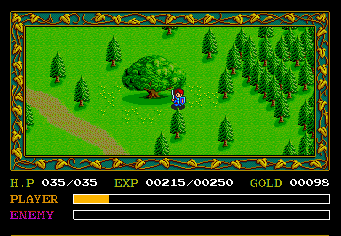
As part of knocking stuff off my list, I started in on Ys I & II for the Turbo Duo, and I polished off the first game, or first half of the larger game, a few days ago. A little Ys goes a long way, so I decided to take care of another title before going back for seconds on Ys. I doubt my opinion on Ys is going to change with Book II, though, so let's start now.
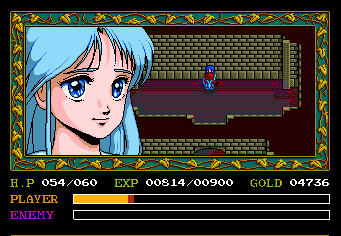
When I played Ys III for the Super Nintendo, I was underwhelmed. I thought it was fine, serviceable, but as undistinguished and unmemorable as an RPG could be while still not being bad. Given the esteem in which the Ys series is held, I chalked this up to playing a port of a CD-based game on a non-CD-based system. As mentioned, I was attracted to Ys I & II based on the elements Lunar apparently borrowed from it - I wanted to see how deep the parallels went - and I thought that the true developer's vision, unfettered by port compromises, would surely deliver an improved experience, but...but.
I doubt any major action RPG to date has featured more basic combat. You have a little tiny sprite, the same size as a Final Fantasy NES overworld sprite. You attack enemies by...running into them. They do the same. You have no other means of attack (though I understand you learn a fire spell in Ys II). It's not totally mindless - you have to approach enemies from the side or back, or be aggressive and charge them first, to avoid taking damage in clashes - but it's as close as a game of the era could get without gameplay being an illusion altogether. You can derive some entertainment from leveling up so much beyond your foes that so you can just walk back and forth in a corridor mowing them down, which is fun, if dumb. Boss battles are particularly stupid, though; given the weird rules of combat, they either rely on stage hazards for damage, or they're designed to be over in seconds given that the hero can survive only so much prolonged contact with the enemy.
I was originally going to launch into a comparison of my time with Ys I & II and my experience with Ultima I, assuming that Ys, too, was released in the infancy of the RPG genre, before anyone had established any sort of genre rules or knew what they were doing, but I'm looking at release dates, and it seems that Ys I (it's still incredible that this was released as a standalone game) came out in 1987. The original Zelda, with its straightforward yet robust combat that's satisfying to this day, was released a year earlier. Furthermore, the Turbo CD version I played was released in '89. Considering when CD-ROMs became a media standard, the release date makes sense, I guess, but Ys gameplaywise feels like it's from a much more primitive era.
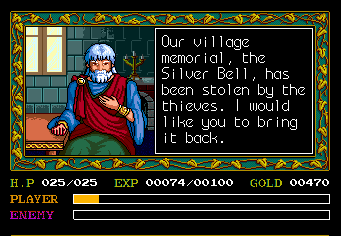
The structure of the quest is also shockingly bare-bones for its day. Adol arrives in the starting village by boat, whereupon a local fortuneteller summons him and asks him to collect a series of lost books containing the history of ancient Ys, a utopian floating continent that mysteriously vanished hundreds of years ago. He can then travel to the traditional RPG Second Town beleaguered by bandits or scoundrels or some sort of threat - the Arima, so to speak - where he explores a nearby dungeon and thereby solves the problem. In a typical RPG, this would be the starting, training-wheels area, the hero's first step into a larger world...but this is the near-total extent of Ys I's world. It's the First Town, the Second Town, and the Field Between. After you explore Second Town's shrine and solve the bandit problem, you go to the second dungeon, the Mine...and after that is the last dungeon. It's a massive one, a tower spanning 30 floors that is hugely unbalancing to the game progression...but the game world is two towns, two dungeons, and then the end. It took me about seven hours from start to finish, and that was only because I wasn't using a guide and there's one point where the way to progress is relatively obscure.
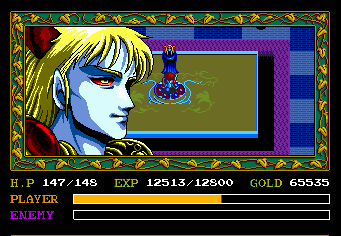
The story, similarly, is extremely underdeveloped. The final boss of Ys I is named "Dark Fact." "Fact" is the name of one of the sages who safeguarded Ys, as you learn from the title of one of the books they wrote that you're gathering. From this, and knowing that TSS ripped off Ys in several respects, you can presume that Fact is the Ghaleon analogue, the "fallen" member of the group of venerated guardians. You meet Dark Fact once, when you fight and kill him; he just issues generic threats and doesn't mention his past at all. No one else in the cast comments on this, either. Perhaps the most interesting twist to Ys's story - the one which Lunar fashioned into its crown jewel - is literally completely unexplored. Perhaps Book II, set in Ys itself, offers elaboration, but I'm not holding my breath.
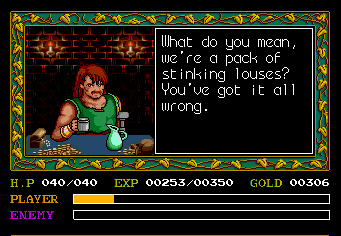
Let's look at positives. The first is music, for which Falcom is renowned; here, the composer is Mr. Streets of Rage Yuzo Koshiro, and the game takes full advantage of its CD sound. Koshiro doesn't let the video game medium or the rinky-dink graphics hold him back; these tunes have an unrestrained guitar-rock power and strength, frequently lasting for far longer than the scenes they score (and, frankly, dwarfing the actual on-screen events). The script is largely written well and naturally, and the acting, while more layperson than professional voice actor à la Working Designs, is respectable and far exceeds the standard of the day. I think, on the whole, that the title uses the CD medium better than The Silver Star; most of the score could be delivered only by CD sound (whereas TSS has a decided mix between more orchestral tracks and plain ol' chiptuney compositions), and the accoutrements that take advantage of the enhanced storage space - voice acting, huge character portraits - are distributed more evenly throughout the game (though this could be because the game is just a handful of hours, and not ones effectively-spent). How the game handles most of its animations is interesting; instead of cutting to a separate scene, Ys will just slide a cutout of the character's anime portrait over the overworld scene, whereupon they will start chatting animatedly (literally), in full voice. It works better than it sounds, and I found it a refreshing change of pace from the usual CD game presentation. The game actually has very few fully-animated cutscenes, though - just in its attract mode and at the beginning and end. They're done very well, mind. A comparison with Lunar, however, reveals how the reward of a few frames of animation before entering a new locale underlines the impact of visiting strange new places. (Maybe it's because, well, Adol *doesn't* really visit many strange new places, and hardly anything happens in the game.)
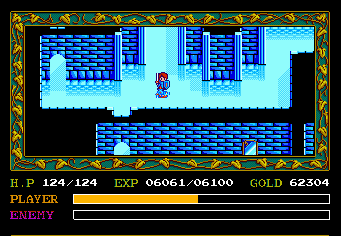
The combat system does have one lone wrinkle in a number of rings you can equip for different effects - double damage, double defense, halving enemy speed, etc. It's a significant choice and affects your tactics - particularly given that it's your only vestige of customization. There's also an effective screw-you where after going past the end tower's point of no return, your gleaming silver equipment is stolen, making for the one time I've seen an RPG reward a player for hanging on to their previous equipment set instead of selling it. It also forces you to fight the final battle with what is at that point suboptimal equipment. Granted, this would have been more of a test of skill in a title with something approaching a robust combat system. And at least the paucity of options makes menu operation fast, efficient, and disposable, much like combat itself.
I do find it refreshing, though, that Ys spotlights smaller crises. They're the modest goals the start of a D&D campaign will typically hand you: "You're a vagabond who just arrived in town. The local fortuneteller hires you to recover a relic from a nearby shrine." "A mysterious cloaked man is stealing silver items from town! Can YOU figure it out?" It's a nice change of pace from killing God all the time.
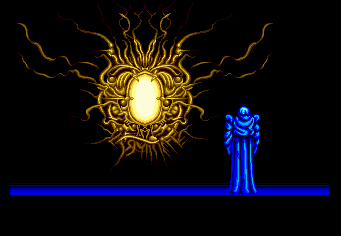
I don't think, however, that I'm gonna get into Ys. After a bit of Wikipedia searching - nothing on what awaits me in Ys II; just on the basic premises of a couple other games - I find it interesting, for the series as a whole, that its current world is seemingly a footnote; you're basically an inadvertent action archaeologist (Adol is no scholar, just an accidental tourist) uncovering the history of an extinct but much more interesting civilization across adventures. The gameplay, though, is bad enough to keep me away. I looked up Ys IV, aware that two versions had been made due to the departure of the original Ys team - and both of them (both of them!) reverted to the run-into-enemies school of stubby sprite "combat." I don't trust any series handed to people who thought that was the wave of the future.

